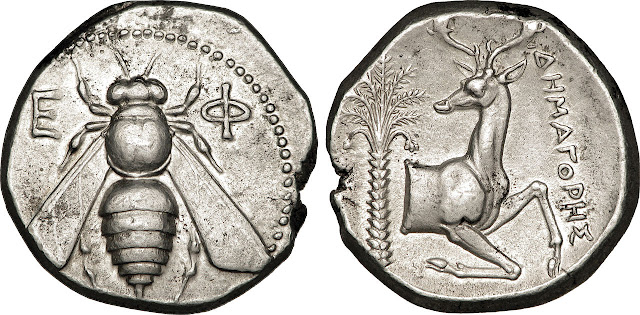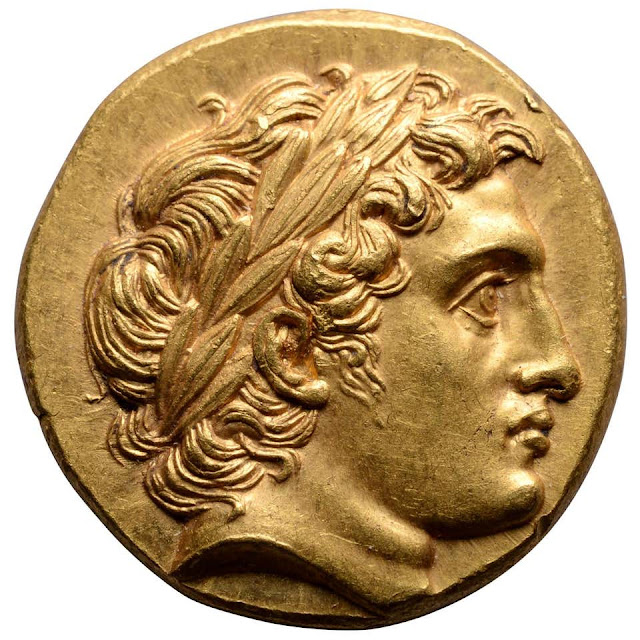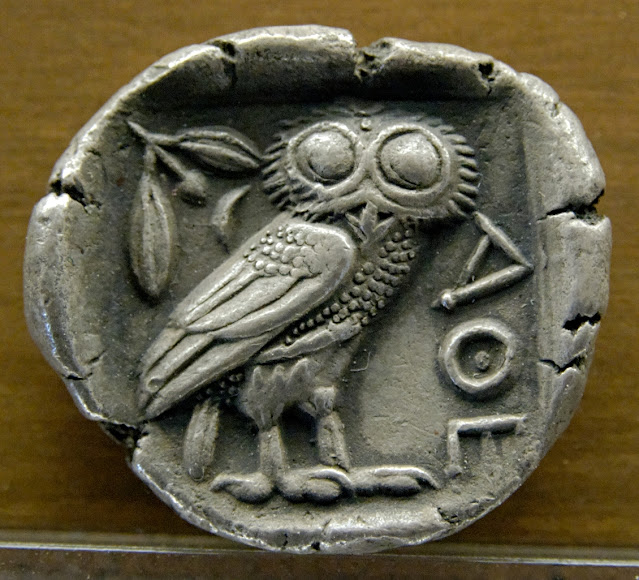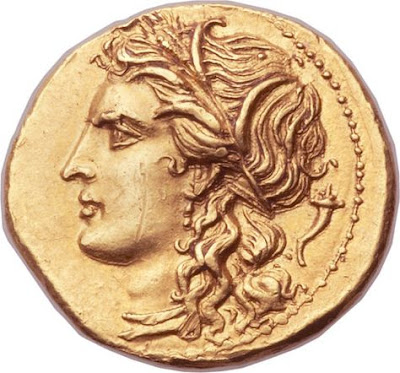A silver tetradrachm minted in Carthage, 330-300 BCE. Obv.: head of the goddess Tanit with dolphins. Rev. : horse's head and palm tree. The legend reads 'm mhnt' meaning 'people of the camp', that is army camp. Many such coins were minted to pay mercenaries. (British Museum, London)
Tetradrachm of Athens (c. 454–404 BC) Obverse: a portrait of Athena, patron goddess of the city, in helmet Reverse: the owl of Athens, with an olive sprig and the inscription "ΑΘΕ", short for ΑΘΕΝΑΙΟΝ, "of the Athenians"
Athens, 467-465 BC. Silver Dekadrachm (43.38 g). Head of Athena right, wearing single-pendant earring, necklace, and crested Attic helmet decorated with three olive leaves over visor and a spiral palmette on the bowl / ΑΘΕ (ΑΘΗΝΑΙΩΝ - of Athenians), owl standing facing, wings spread; olive sprig and crescent to upper left; all within incuse square.
A Syracusan tetradrachm (c. 415–405 BC) Obverse: head of the nymph Arethusa, surrounded by four swimming dolphins and a rudder Reverse: a racing quadriga, its charioteer crowned by the goddess Victory in flight.
Greek Coins
Dionysius I 405-367 avant J.-C. Décadrachme, Syracuse, AG 43.06 g Avers : Quadrige bondissant à gauche conduit par un aurige, tenant les rênes et le kentron, couronné par une Niké volant à droite ; ligne d'exergue épaisse ; à l'exergue, trophée d'armes constitué d'une javeline, d'une cuirasse et d'un casque attique. Revers : Tête de Perséphone (ou Aréthuse) à gauche, couronnée d'épis avec des boucles d'oreilles et un collier de perles, entourée de quatre dauphins.
Silver tetradrachm, Knossos, Crete. 2nd-1st century BCE. O: Zeus, R: Labyrinth. (Alpha Bank Numismatics Collection, Kerkyra, Corfu)
Top row (L to R):
Cos (300-190 BCE) Silver tetradrachm, crab.
Syracuse (c. 400 BCE) - Silver decadrachm, head of Arethousa with dolphins.
Macedon (306-283 BCE) - Silver tetradrachm, Poseidon with trident.
Bottom row (L to R):
Euboea (c. 485 BCE) - Silver tetradrachm, octopus in incuse square.
Knossos (2nd-1st century BCE) - Silver tetradrachm, labyrinth.
Corinth (386-307 BCE) - Silver stater, Pegasus.
(Alpha Bank Numismatics Collection, Kerkyra, Corfu)
Silver tetradrachm from Macedonia, reign of Perseus, 179-168 BCE. O: Head of Perseus. R: Eagle on a thunderbolt in a wreath of oak.
 Silver tetradrachm from Macedonia, reign of Antigonus Doson, 229-221 BCE. O: Head of Poseidon. R: Apollo on a ship's prow.
Silver tetradrachm from Macedonia, reign of Antigonus Doson, 229-221 BCE. O: Head of Poseidon. R: Apollo on a ship's prow.An electrum coin minted in Carthage showing the goddess Tanit and horse. 4th-3rd century BCE. (British Museum, London)
A silver tetradrachm minted under King Perseus of Macedon. Issued under magistrate Zoilos at the Pella or Amphipolis mint, circa 174 - 173 BC
Two coins issued by Ptolemy I:
1) A portrait of the deified Alexander the Great wearing an elephant scalp on his head, with a ram’s horn over his temple, and an aegis (sacred fleece) over his shoulder; on the reverse Athena Alcidemus, the patroness of Pella
Silver tetradrachm, Alexandria, c. 312/1-305 BCE; Nomos no. 12, lot 120.
2) A portrait of Ptolemy with diadēma (royal headband) and aegis; on the reverse a deified Alexander holding a thunderbolt and scepter standing in a chariot drawn by four elephants
Gold stater, Cyrene or Alexandria, c. 305/4-298 BCE; CNG no. 84, lot 751.
 Coin of Alexander the Great
Coin of Alexander the GreatAnd that is to the Ptolemaic queen Arsinoe II. Now you can be forgiven for not knowing which Ptolemaic queen that was, exactly, because they were all named Arsinoe and Berenike, or, later, Cleopatra (the famous one is Cleopatra VII).
PHILIP III OF MACEDON
Demetrius I Soter
Beautiful Coin of Hieron II
Gold Stater ancient coin with Portrait of Alexander the Great, from the Colosseo Collection































